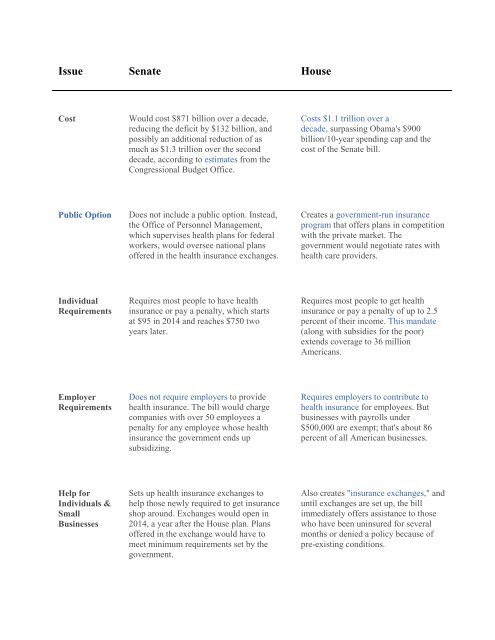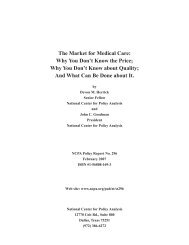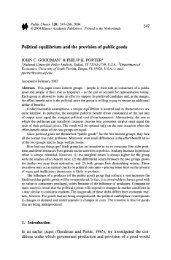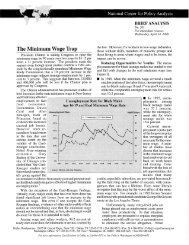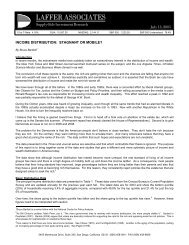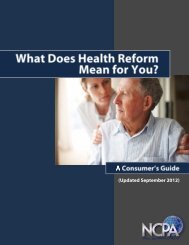Side-by-side comparison of the House and Senate bills
Side-by-side comparison of the House and Senate bills
Side-by-side comparison of the House and Senate bills
Create successful ePaper yourself
Turn your PDF publications into a flip-book with our unique Google optimized e-Paper software.
Issue <strong>Senate</strong> <strong>House</strong><br />
Cost<br />
Would cost $871 billion over a decade,<br />
reducing <strong>the</strong> deficit <strong>by</strong> $132 billion, <strong>and</strong><br />
possibly an additional reduction <strong>of</strong> as<br />
much as $1.3 trillion over <strong>the</strong> second<br />
decade, according to estimates from <strong>the</strong><br />
Congressional Budget Office.<br />
Costs $1.1 trillion over a<br />
decade, surpassing Obama's $900<br />
billion/10-year spending cap <strong>and</strong> <strong>the</strong><br />
cost <strong>of</strong> <strong>the</strong> <strong>Senate</strong> bill.<br />
Public Option<br />
Does not include a public option. Instead,<br />
<strong>the</strong> Office <strong>of</strong> Personnel Management,<br />
which supervises health plans for federal<br />
workers, would oversee national plans<br />
<strong>of</strong>fered in <strong>the</strong> health insurance exchanges.<br />
Creates a government-run insurance<br />
program that <strong>of</strong>fers plans in competition<br />
with <strong>the</strong> private market. The<br />
government would negotiate rates with<br />
health care providers.<br />
Individual<br />
Requirements<br />
Requires most people to have health<br />
insurance or pay a penalty, which starts<br />
at $95 in 2014 <strong>and</strong> reaches $750 two<br />
years later.<br />
Requires most people to get health<br />
insurance or pay a penalty <strong>of</strong> up to 2.5<br />
percent <strong>of</strong> <strong>the</strong>ir income. This m<strong>and</strong>ate<br />
(along with subsidies for <strong>the</strong> poor)<br />
extends coverage to 36 million<br />
Americans.<br />
Employer<br />
Requirements<br />
Does not require employers to provide<br />
health insurance. The bill would charge<br />
companies with over 50 employees a<br />
penalty for any employee whose health<br />
insurance <strong>the</strong> government ends up<br />
subsidizing.<br />
Requires employers to contribute to<br />
health insurance for employees. But<br />
businesses with payrolls under<br />
$500,000 are exempt; that's about 86<br />
percent <strong>of</strong> all American businesses.<br />
Help for<br />
Individuals &<br />
Small<br />
Businesses<br />
Sets up health insurance exchanges to<br />
help those newly required to get insurance<br />
shop around. Exchanges would open in<br />
2014, a year after <strong>the</strong> <strong>House</strong> plan. Plans<br />
<strong>of</strong>fered in <strong>the</strong> exchange would have to<br />
meet minimum requirements set <strong>by</strong> <strong>the</strong><br />
government.<br />
Also creates "insurance exchanges," <strong>and</strong><br />
until exchanges are set up, <strong>the</strong> bill<br />
immediately <strong>of</strong>fers assistance to those<br />
who have been uninsured for several<br />
months or denied a policy because <strong>of</strong><br />
pre-existing conditions.
Financial<br />
Assistance<br />
Includes subsidies to help cover those<br />
making up to 400 percent <strong>of</strong> federal<br />
poverty level -- currently $88,000 per<br />
year for a family <strong>of</strong> four -- <strong>and</strong> exp<strong>and</strong>s<br />
<strong>the</strong> Medicaid program to include those<br />
making 133 percent <strong>of</strong> <strong>the</strong> federal<br />
poverty level.<br />
Also includes subsidies to help those<br />
making up to 400 percent <strong>of</strong> <strong>the</strong> federal<br />
poverty level pay for health insurance<br />
premiums. The <strong>House</strong> bill would<br />
exp<strong>and</strong> Medicaid eligibility for lowincome<br />
individuals <strong>and</strong> families, cover<br />
new preventive services, <strong>and</strong> increase<br />
payments for check-ups.<br />
New Taxes<br />
Imposes a 40 percent tax on high-cost<br />
health insurance plans -- those valued<br />
over $8,500 per individual or $23,000<br />
per family. Charges a 10 percent tax<br />
on indoor tanning services, which is<br />
expected to raise $2.7 billion in <strong>the</strong> first<br />
ten year period. Also increases Medicare<br />
payroll taxes -- from 1.45 to 2.35 percent --<br />
on individuals earning $200,000 a year<br />
<strong>and</strong> couples earning $250,000.<br />
Would tax <strong>the</strong> wealthiest<br />
Americans, with individuals making<br />
over $500,000 <strong>and</strong> families making<br />
above $1 million paying a surcharge on<br />
a portion <strong>of</strong> <strong>the</strong>ir income.<br />
Abortion<br />
Would create a "firewall" to prevent<br />
federal subsidies from going toward<br />
abortion coverage. In plans that do cover<br />
abortion, beneficiaries would have to pay<br />
for it separately, <strong>and</strong> those funds would<br />
have to be kept in a separate account from<br />
taxpayer money.<br />
Would ban abortion from being covered<br />
in <strong>the</strong> new public plan except in cases <strong>of</strong><br />
rape, incest, or threat to <strong>the</strong> life <strong>of</strong> <strong>the</strong><br />
pregnant woman. Also bans people<br />
from using government subsidies to<br />
purchase private plans with abortion<br />
coverage on <strong>the</strong> exchange.<br />
Medicare<br />
Changes<br />
Would reduce Medicare spending <strong>by</strong><br />
approximately $395 billion over 10 years;<br />
includes cuts to private insurance plans<br />
(although implemented slightly differently<br />
from <strong>House</strong> bill). Also in 2010, Medicare<br />
beneficiaries would receive $500 towards<br />
paying for prescription drugs not currently<br />
covered because <strong>of</strong> cost, those that fall into<br />
<strong>the</strong> so-called "doughnut hole."<br />
Would reduce Medicare spending <strong>by</strong><br />
approximately $440 billion over 10<br />
years, largely <strong>by</strong> reducing payments to<br />
private insurance plans that serve<br />
Medicare patients (<strong>and</strong> are currently<br />
paid more than <strong>the</strong> cost <strong>of</strong> providing<br />
that care) <strong>and</strong> <strong>by</strong> requiring hospitals <strong>and</strong><br />
o<strong>the</strong>r health care providers to operate<br />
more efficiently. Also includes several<br />
new benefits for seniors, including more<br />
preventive care services<br />
Source: NPR research <strong>and</strong> Kaiser Health News.


